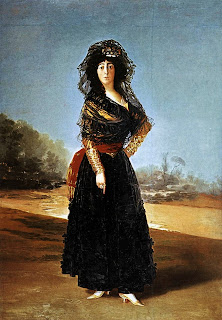Francisco de Goya is considered a
bridge between art of the past and art of the present because he was the first
to so uniquely ignore traditions like realism (lowercase "r"). He took his inspiration from his own
imagination and set a revolutionary precedent over artists to come. A man who was way ahead of his time, Goya
does not really fit into any stylistic period of art history, one might say;
nevertheless, much of his work did take inspiration from Romantic art
theory. To observe his artistic style,
however, is to take a look at something that is unique to itself, a kind of
exception to the rules, and something only to be understood when understanding
the man himself. Let's take a look.
The Duchess of Alba was one of the
wealthiest persons in Spain. Her
eccentric personality led the public to hold in its eye a rather controversial
opinion of her. This general disfavor
was not just based upon her manner or her private life but more largely on her
scandalous behavior in public. The story
goes that she had invited the queen to a ball but had sent spies to the queen's
palace to find out what gown she was going to wear. She then had all her servants dress
identically as the queen. Naturally, the
queen was so insulted by this prank that she rebuked the prankster, and the
Duchess of Alba was then promptly exiled from Madrid.
It has been rumored that the
duchess and Goya were lovers, but it is not known for sure exactly what the
extent of their relationship was like.
Goya's portraits of her (of which there are several) all picture her
delicately and beautifully. Here she is
seen looking straight at the viewer with large, black eyes. She wears two rings bearing the names Goya
and Alba, implying a union between the two.
Whether they were or were not lovers, however, it would seem that the
duchess eventually left him anyway, and when Goya's painting was cleaned after
his death, the word "solo" was found inscribed in the sand before the
artist's name at the bottom. The
duchess, you will notice, is pointing to it.

No comments:
Post a Comment